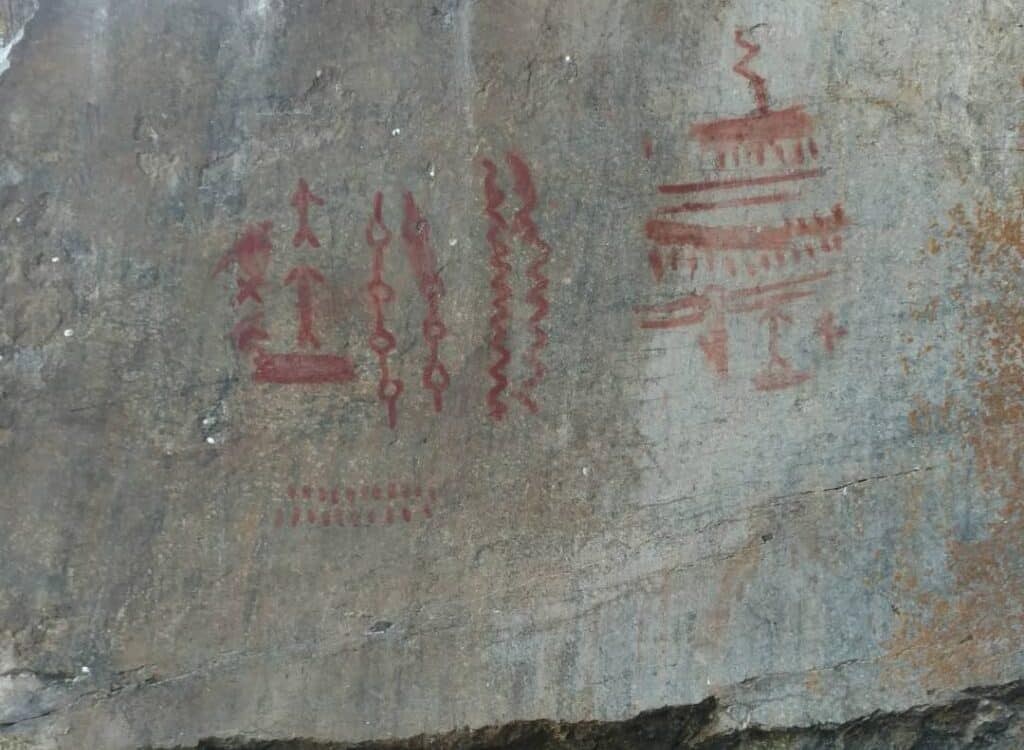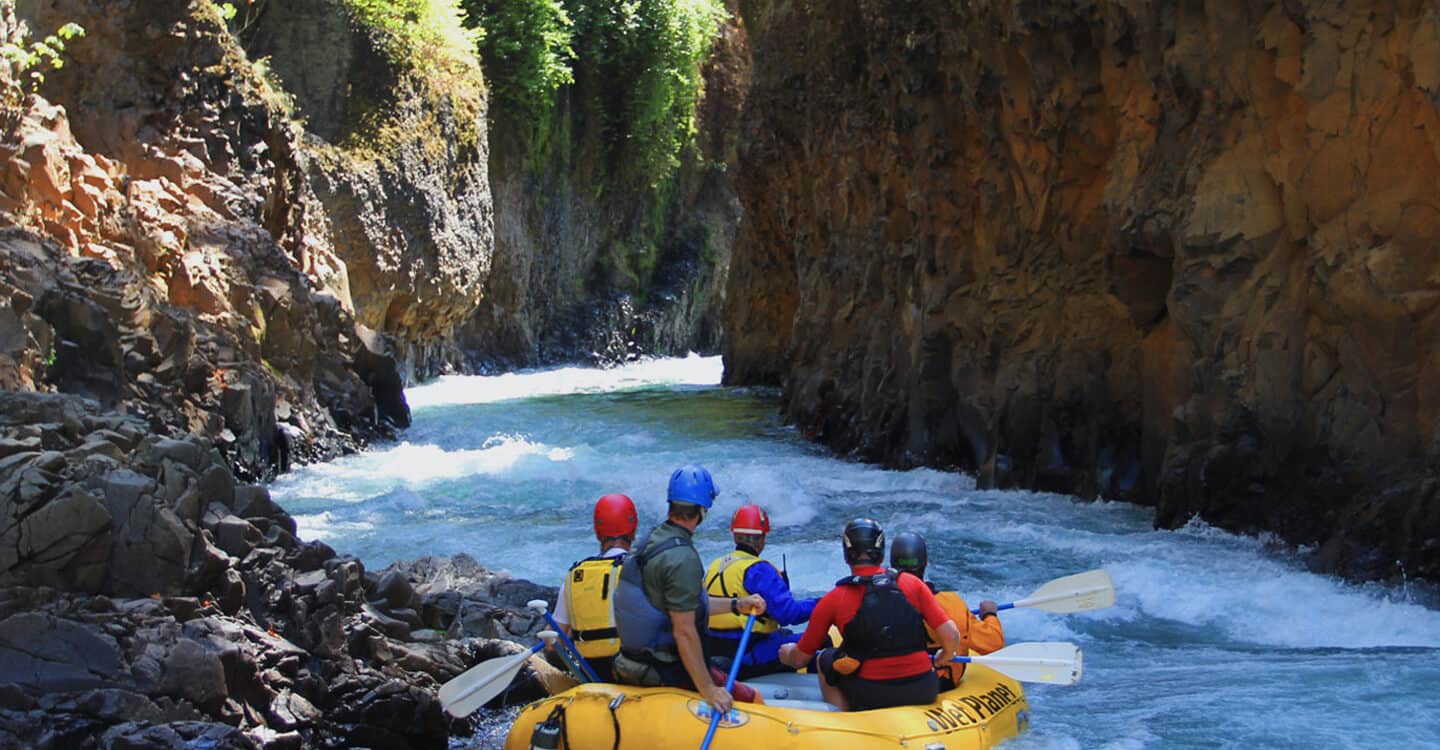There are numerous reasons to love a rafting trip on the Main Salmon. We can name quite a few: fun and big whitewater, clear fresh water, beautiful green forests, incredible wildlife, and a lot of really cool history!
When you travel through the river canyons of the Main Salmon, it’s easy to feel the awe, tranquility, and calling that so many explorers, tribes, and homesteaders felt before us. While the history of this river stretch, dubbed “The River of No Return” is plentiful, We’re going to dive into some of the “big names” of the Salmon River:
Nez Percé
Lewis & Clark
Sacagawea & the Northern Shoshone
Hunters, Trappers, & Homesteaders
Nez Percé
The earliest inhabitants of the river canyon made their way through the Rocky Mountains south to the Salmon River canyon. These early travelers that settled 8,000-11,000 years ago eventually became the people of the Nez Percé tribe. The Nez Percé called themselves the Nimiipu, “the people.” Nez Perce is French for “pierced nose.” But the Nimiipu did not pierce their noses, so it is believed that French trappers and fur traders generalized, lumping them together with nearby groups in the Pacific Northwestern region who may have sported such adornments.
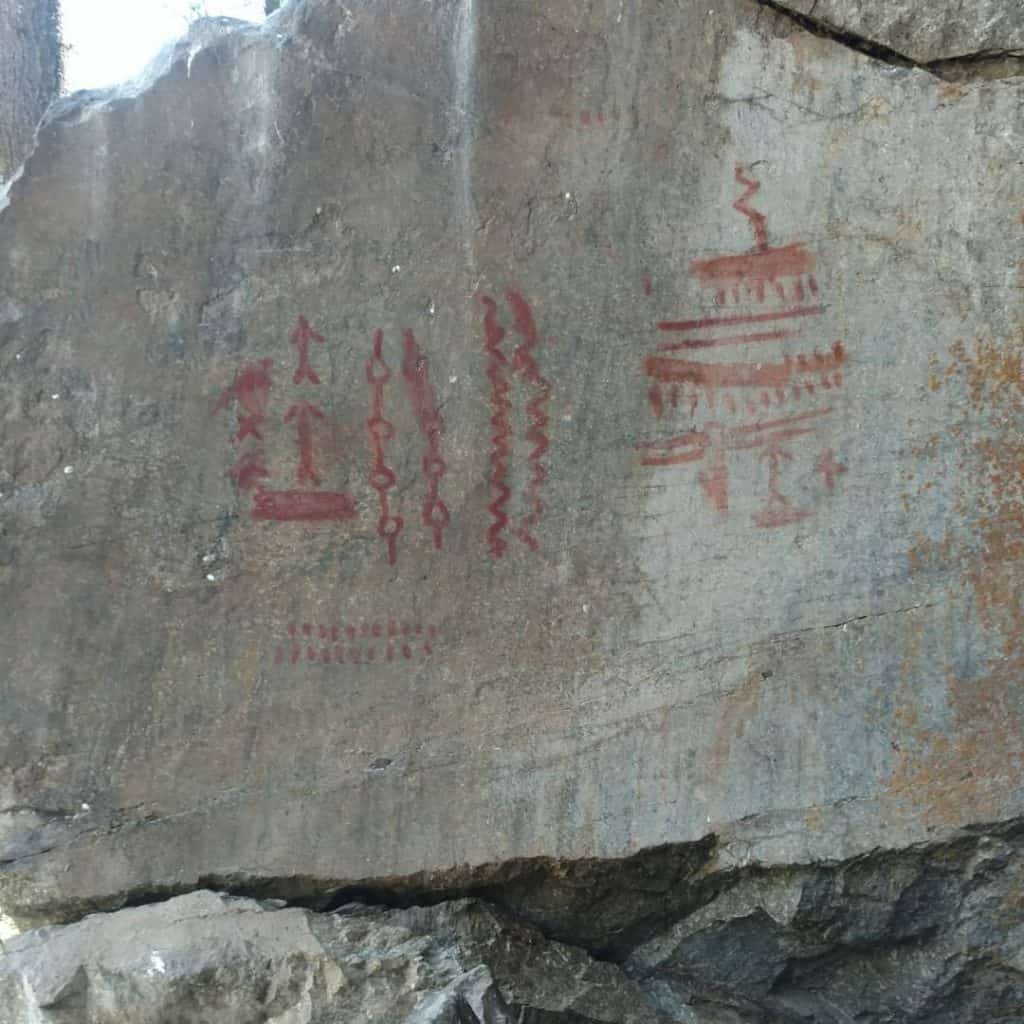
The Nimiipu were fishermen, hunters, and gatherers. Living a semi-nomadic lifestyle, they moved from the plains to the rivers as the seasons changed the location of their provisions. They fished along the Salmon River, the Clearwater, and the Snake in the spring and summer. They would also forage in the surrounding forests for berries, roots, and mosses. Once horses were introduced to the region around the mid-1700s, many groups used them to cross the mountains to hunt buffalo, deer, and other wild game on the mid-western prairies.
For the Nimiipu people, the Salmon River, an essential food source with its then-abundant Salmon was regarded as sacred, and treated as such. Prior to our modern-day hydro dams, the Salmon River provided 45% of Steelhead trout and Chinook Salmon in the entire Columbia watershed!
Today, after years of legendary resistance to the effects of Manifest Destiny, Nimiipu can be found living on and near the Colville Reservation in Washington and Idaho’s Lapwai Reservation. But, Nimiipu territory once ranged from present-day Western Montana and Central Idaho to Northeastern Oregon and Southeast Washington. The Nimiipu acted as gatekeepers of trade between the northeast, beyond the Rocky Mountains, and the northwest coastal region. Anything or body that crossed the plains of the Northwest probably passed through the territories of the Nimiipu.
Also, check out a Nez Percé creation story from Wet Planet staff member Todd Collins.
In 1805, William Clark became the first known Euro-American to meet the Nez Percé, and this meeting played a pivotal role in the success of their journey toward the Pacific Ocean.
Lewis & Clark
A lot of people have heard about Lewis and Clark, but in case you haven’t heard of them, or don’t know why they’re famous, here is a super quick overview:
Meriwether Lewis and William Clark were American explorers who led the famous Corps of Discovery expedition from 1804 to 1806. Commissioned by Thomas Jefferson, their mission was to explore and map the newly acquired Louisiana Purchase territory looking for a suitable waterway for trade. They crossed the western half of the United States starting out in St. Louis, Missouri, and ending their epic endeavor on the Oregon coast near what is now Astoria, more than 2 years later. Pretty incredible, especially for that time.
Enter, the Salmon River…
About a year into their expedition, Lewis and Clark were confronted with the Salmon River. Atop Lemhi pass looking down into the Lemhi valley, with steep mountainsides filled with rushing streams, their hopes of finding a navigable waterway west quickly faded. The two explorers, turned around in a rugged wilderness, short of food, with a bitter winter coming they turned to the local Shoshone people for help. Lewis requested help from Chief Cameahwait to reach the ocean via the river.
Cameahwait swiftly crushed the dream of a water passage to the western coast. He warned of a river so fast and so violent that no boat could navigate its rapids, of canyons so steep as to make passage along the banks impossible. Clark was skeptical and curious to see for himself. So the explorers split routes. Clark took eleven men to scout and prepare boats to travel down the Salmon River. Meanwhile, Lewis and the remaining crew prepared for an overland portage of unknown length and difficulty.
On his way, Clark passed another Shoshone village. They too warned him of the troubled waters ahead. Clark carried on to a point near present-day North Fork, Idaho, and for the first time, laid eyes on the mighty Salmon River.
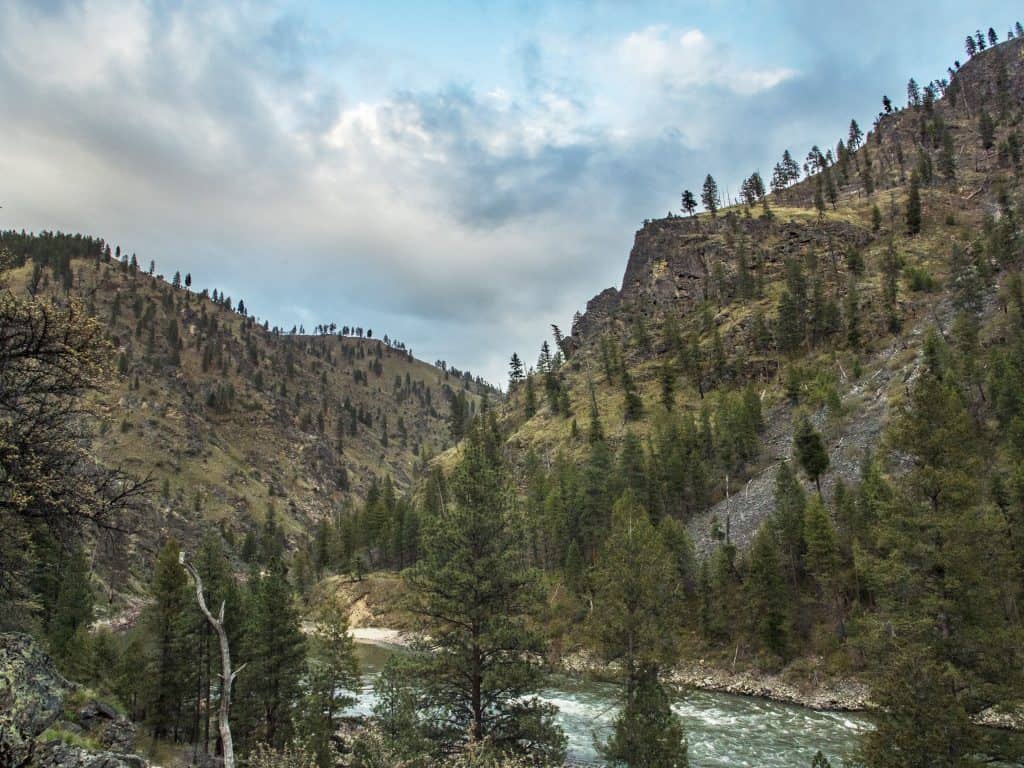
Finally, understanding all of the warnings, Clark turned back and prepared himself for a long overland portage.
On August 23, 1805, he wrote in his journal:
“The River from the place I left my party to this creek is almost one continued rapid, five very considerable rapids the passage of either with canoes is entirely impassable, as the water is confined between huge rocks and the current beating from one against the other for some distance below . . . at one of those rapids the mountains are so close as to prevent a possibility of a portage with great labor. . . as running them would certainly be productive of the loss of some canoes . . . and below my guide and many other Indians tell me that the mountains close and there is a perpendicular cliff on each side and continues for a great distance and that the water runs with great violence from one rock to the other on each side foaming & roaring through rocks in every direction. So as to render the passage of anything impossible.”
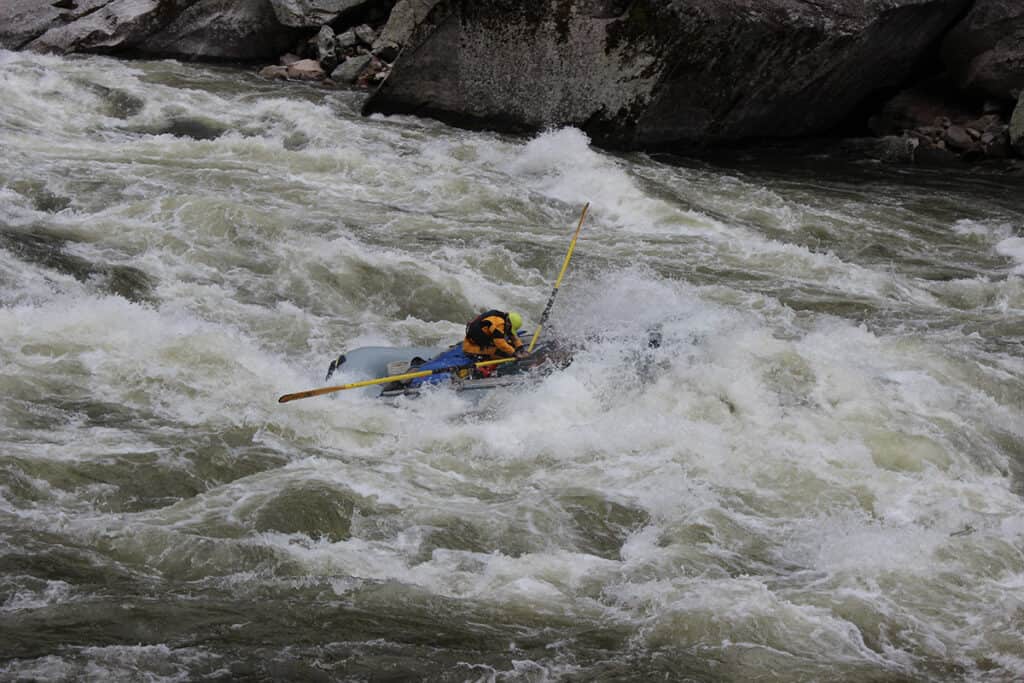
Lewis and Clark loaded their horses and set out with the guidance of a small band of Cameahwait’s Shoshone, one of whom was the infamous Sacagewea. They would have to weave north around the Salmon, across the Lemhi Valley, and through the Bitterroot Mountains. There, the trials of thick forest, bitter cold, and near starvation rivaled the perils of navigating the Salmon River.
Eleven days later, they emerged from the mountain forests on the edge of the expansive Weippe Prairies, a thousand feet above the Clearwater River.
Sacagawea & the Nothern Shosone
It was indeed the northern Shoshone that warned Lewis and Clark of how challenging river travel would be on the Salmon River. The sister of Chief Cameahwait was no other than Sacagawea who was vital in translating and helping the explorers to complete a safe journey through the area.
Along the Main Salmon, you’ll find pictographs attributed to the Bitterroot cultures. The Northern Shoshone were hunter-gatherers that ranged along the Salmon River canyon and extended far into the Bitterroot and Sawtooth Mountains. They and their ancestors painted their stories and beliefs on the walls of the Salmon River canyons and etched their legacy on the walls of history.
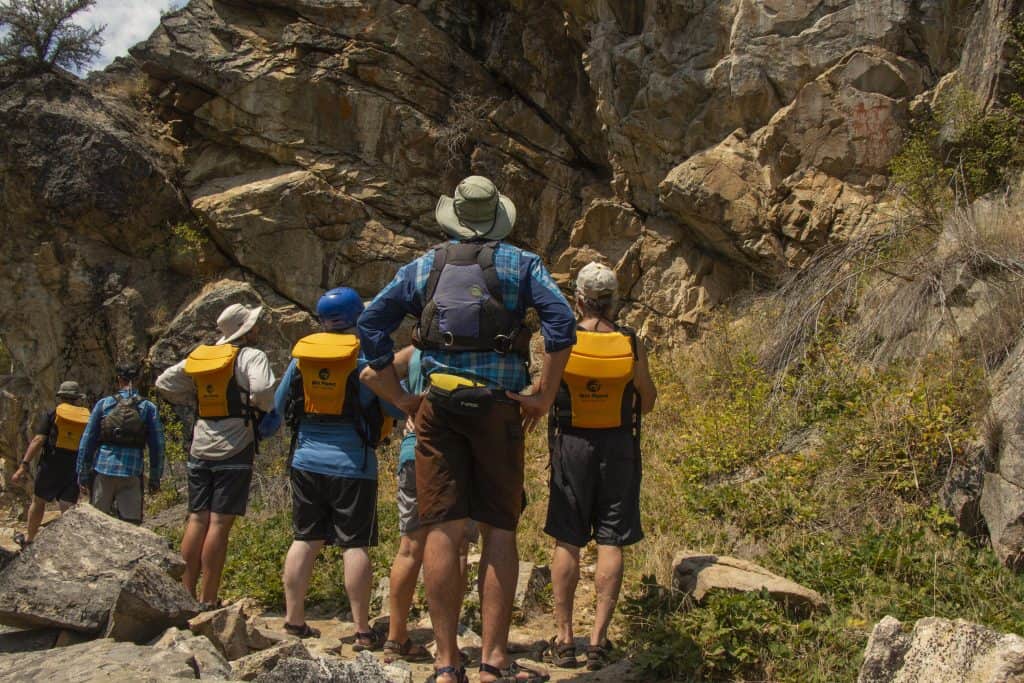
In 1805 when Lewis and Clark accepted help from the Shoshone, they estimated there were about 500 then living on the land under Cheif Cameahwait. The most famous of the Shoshone was Sacagawea.
Sacagawea was captured in a raid by the Hidatsa as a young girl and brought to Hidatsa-Mandan villages in North Dakota. There, she was bought and impregnated by the French trapper Charbonneau, who thought of her as his wife. In 1804, Captain William Clark hired her and Charbonneau as translators: Sacagawea spoke Shoshone and Hidatsa, Charbonneau spoke Hidatsa and French; expedition member Francoise Labiche spoke French and English. When the time came to procure horses and help from the Shoshone, Clark knew this chain of translation would prove invaluable.
On the trail, Sacagawea gave birth to Jean Baptiste Charbonneau. The presence of a woman with a newborn on her back helped to ensure peaceful reception by the many native groups who may have otherwise perceived the group as a war party. At the expedition’s end, Charbonneau received $500 and 320 acres of land. Sacagawea received nothing.
And for their invaluable assistance and support, Cameahwait’s Shoshone were promised a leading role in the trade relations to come with westward expansion. Of course, these expectations were never fulfilled. Over the years, the Northern Shoshone remained peaceful and helpful when possible to the expanding settlers. But as other groups moved to resist the incoming hordes, the Shoshone were pulled into the fray. When Bannock fighters were invited to find refuge among them in 1878, they drew the attention of the U.S. Army and local vigilante groups. The Shoshone and their Bannock absconders were hunted out and sent to Fort Hall Reservation in Idaho.
For more on the Northern Shoshone and a descriptive story, check out this expanded blog from Staff member Todd Collins.
Hunters, Trappers, & Homesteaders
As time passed more people and opportunity was sought in the Lemhi Valley and the Salmon River Canyon. In the late 1800s early 1900s, railroad companies looked at the river for a potential route west. These attempts found the route too impractical with the challenging terrain. However, in the 1880s, hard rock mining started booming, which led to a huge demand for wooden scow boats to haul all the necessary machinery to the mines. For nearly four decades, a man named Captain Gulelke built solid 32-foot long and 8-foot wide wooden scows in Salmon, ID. He would use these scow boats to ferry people and supplies down the river to Riggins, ID. Once in Riggins with no way back up river, these boats would be dismantled and used to build homes, buildings, and other practical uses. Guleke was known to complete as many as 200 trips down the Main Salmon and charged a pretty penny for his charters.

There was also “Buckskin Bill” who settled in the Salmon Canyon in 1929. Establishing a true mountain man lifestyle, he managed to settle on 50 acres of land, build a two-story home, a blacksmith shop, and even a bomb shelter for only one dollar! Buckskin Bill crafted his own knives and guns. There is even a museum at Five-mile Bar.
Let’s not forget about the remarkable women who made their mark on the Salmon River. There was Polly Beamis, a young Chinese girl who had been sold into slavery, that eventually ended up in the mining town of Warren Idaho. It’s unclear how she found her freedom, but she eventually married Charlie Bemis and the two set up shop on a bar along the Main Salmon. Then there’s Reho Wolfe, who raised a whole bunch of kids in a cabin right on the river, even fighting the state of Idaho for her right to homeschool – now that’s some strong-willed mama!
Frances Zaunmiller deserves a shoutout too. From 1940 to 1986, she was the fierce soul living and working at Campbells Ferry, proving that women can handle anything that comes their way. There were plenty of other tough and resourceful women who left their mark, and even today, the Salmon River is home to some resilient women and men all year round.
The river kept evolving over the years, and by 1947, Glen Wooldridge made history by being the first person to motor his boat upstream. His boat was a 22-footer, made of plywood, and had a 33-hp outboard Evinrude. Around that time, they also started offering commercial recreational trips down the river, giving folks a chance to experience the wild beauty of the Salmon River.
That’s just a handful of the interesting and diverse groups of people that make a deep well of history on the Salmon River. Did we mention we run trips on the Main Salmon and love to talk about the history, amazing geology, and wildlife?

